Top 12 Sheet Metal Worker Skills to Put on Your Resume
In the competitive field of sheet metal work, standing out to potential employers means showing sharp, specific skills that prove you can think, plan, and build with precision. Call out the right abilities, and you signal expertise, consistency, and the kind of adaptability shops lean on when deadlines press and tolerances shrink.
Sheet Metal Worker Skills
- AutoCAD
- SolidWorks
- TIG Welding
- MIG Welding
- Plasma Cutting
- CNC Operation
- Precision Measuring
- Brake Press Operation
- Shearing Machines
- Riveting Techniques
- Sheet Metal Layout
- HVAC Systems
1. AutoCAD
AutoCAD is CAD software for creating precise 2D drawings and 3D models, including fabrication details, bend lines, and assemblies for sheet metal jobs.
Why It's Important
AutoCAD enables exact design and revision control, speeds communication with the shop floor, and helps reduce scrap by catching conflicts before metal is cut.
How to Improve AutoCAD Skills
To sharpen AutoCAD for sheet metal work, focus on:
Core commands first: Get fast with layers, object snaps, polylines, arrays, trim/extend, and blocks.
Sheet metal conventions: Use bend lines, K-factor notes, reliefs, and clear callouts that match shop standards.
3D where it helps: Model simple folds and assemblies to catch clashes and verify fit before nesting.
Reusable content: Build templates, title blocks, and block libraries for holes, hardware, and standard features.
Shortcuts and customization: Map hotkeys, tool palettes, and scripts to speed repetitive tasks.
Clean drawings: Purge unused items, use named views, keep layers disciplined, and dimension with consistent styles.
How to Display AutoCAD Skills on Your Resume
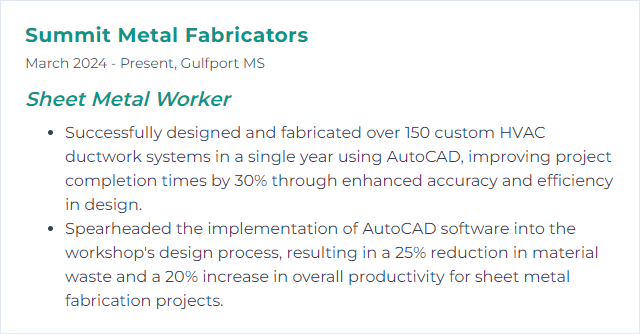
2. SolidWorks
SolidWorks is CAD software for 3D modeling and assemblies, with dedicated sheet metal tools for flanges, hems, reliefs, and flat patterns.
Why It's Important
It speeds the design-to-flat process, predicts developed lengths, and reveals interference or bend issues before fabrication starts.
How to Improve SolidWorks Skills
Level up by targeting the features that matter most on the floor:
Master sheet metal features: Base Flange/Tab, Edge Flange, Miter Flange, Sketched Bend, Forming Tools, and Convert to Sheet Metal.
Dial in bend tables: Maintain accurate K-factors, gauges, and bend deduction charts aligned with your press brakes and tooling.
Flat pattern accuracy: Validate developed lengths against real bends and update tables when shop results shift.
Smart libraries: Create hardware, PEMs, reliefs, and hole patterns as design library features for quick drop-in.
Configurations and design tables: Drive families of parts and quick revisions without rebuilding geometry.
Performance habits: Suppress heavy features, use lightweight mode, and clean mates for snappier assemblies.
Keyboard shortcuts: Keep a printed cheatsheet and practice until muscle memory takes over.
How to Display SolidWorks Skills on Your Resume

3. TIG Welding
TIG (GTAW) uses a non-consumable tungsten electrode and shielding gas to produce clean, precise welds, ideal for thin gauge stainless, aluminum, and specialty alloys.
Why It's Important
TIG delivers tight heat control and beautiful, low-spatter beads with minimal distortion—exactly what thin sheet and visible parts demand.
How to Improve TIG Welding Skills
Build consistency with focused practice:
Clean metal, clean results: Degrease, brush with dedicated tools, and remove oxides before striking an arc.
Tungsten matters: Choose the right type and diameter, grind lengthwise to a point (or slight flat), and keep it sharp.
Torch control: Keep a steady 15–20° torch angle, short arc length, and smooth travel. Add filler sparingly and rhythmically.
Heat management: Use pulse when helpful, clamp heat sinks, and stitch weld to limit distortion.
Practice joints: Lap, butt, T-joints, inside/outside corners—on coupons that match job thickness.
PPE and setup: Correct lens shade, gloves, ventilation, and gas flow tuned for the metal.
How to Display TIG Welding Skills on Your Resume
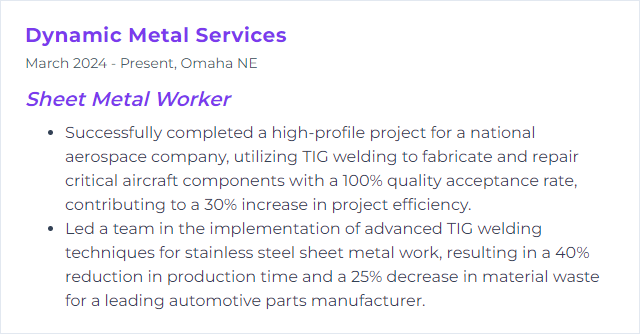
4. MIG Welding
MIG (GMAW) feeds a consumable wire through a gun while an electric arc joins the metals. Fast, forgiving, and efficient across common sheet metal thicknesses.
Why It's Important
It boosts throughput, produces strong welds with minimal cleanup, and handles a wide range of materials and positions.
How to Improve MIG Welding Skills
For cleaner, flatter beads and fewer burn-throughs:
Match wire and gas to the job: For thin steel, 0.023–0.030 in wire is often ideal. Use a suitable gas mix for cleaner arcs.
Tune settings: Voltage, wire speed, and inductance should fit material and joint. Make quick test passes on scrap and adjust.
Technique: Maintain a consistent stickout and travel speed. On thin stock, a push angle can help keep heat down.
Heat control: Short stitch welds, skip patterns, and copper backing reduce warping and blow-through.
Surface prep: Remove paint, oil, scale, and rust. Clean joints weld better. Every time.
Safety basics: Helmet with proper shade, gloves, fire-safe clothing, good fume extraction.
How to Display MIG Welding Skills on Your Resume

5. Plasma Cutting
Plasma cutting drives an ionized gas arc through metal, melting and ejecting material to make quick, precise cuts in plate and sheet.
Why It's Important
It’s fast, accurate, and flexible, slicing complex shapes with clean edges and less rework—great for both thin gauge and heavier stock.
How to Improve Plasma Cutting Skills
Dial in consistency and cut quality:
Right consumables: Match tips and electrodes to material and thickness; replace them before quality drops.
Speed and amperage: Tune travel speed and output to avoid dross, bevel, and excessive kerf.
Standoff control: Keep a steady torch height with guides or CNC; it protects tips and sharpens edges.
Air quality and pressure: Dry, clean air at the recommended pressure improves arc stability and finish.
Grounding: A solid work clamp connection keeps the arc consistent.
Maintenance: Clean torches, check leads, and keep cables tidy to prevent hiccups mid-cut.
Safety: Eye and hearing protection, gloves, flame-resistant clothing, and good ventilation are non-negotiable.
How to Display Plasma Cutting Skills on Your Resume
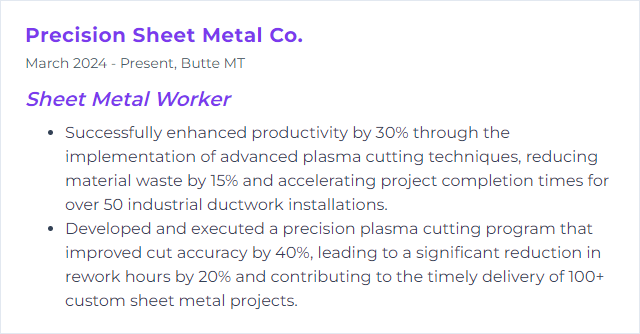
6. CNC Operation
CNC operation uses programmed machines to cut, punch, bend, or form sheet metal with tight repeatability from digital models and CAM toolpaths.
Why It's Important
It delivers accuracy at volume, trims cycle times, improves safety, and keeps parts consistent across runs and revisions.
How to Improve CNC Operation Skills
Raise throughput and quality with smart habits:
Know your materials: Gauge, alloy, hardness, and coatings influence feeds, speeds, tonnage, and tooling choice.
Toolpath strategy: Simulate, then refine lead-ins, micro-tabs, and sequencing to reduce heat and part movement.
Nesting discipline: Tight nests save stock, but leave room where heat or tip-up risk is high.
Preventive maintenance: Lubricate, align, and inspect. Worn tooling and loose backgauges kill tolerances.
Program standards: Use naming conventions, revision control, and shop-approved post processors.
Operator training: Cross-train on setup, probing, and quick changeovers to limit downtime.
Safety: Guards, e-stops, and lockout procedures. No shortcuts.
How to Display CNC Operation Skills on Your Resume
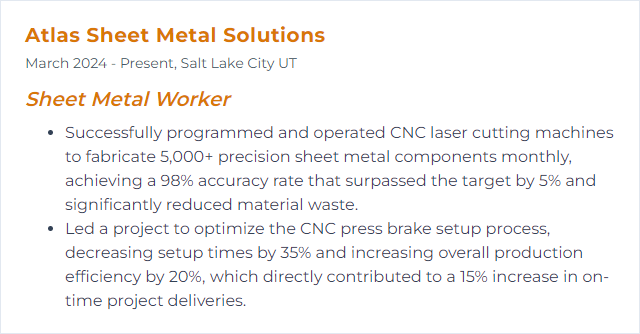
7. Precision Measuring
Precision measuring uses tools like calipers, micrometers, height gauges, protractors, and gauges to verify dimensions, thickness, angles, and hole locations against tolerances.
Why It's Important
It keeps parts within spec, reduces rework, and assures fit during welding, bending, and final assembly.
How to Improve Precision Measuring Skills
Make accuracy your habit:
Quality instruments: Use reliable calipers and micrometers from reputable brands, and protect them.
Regular calibration: Calibrate on schedule and record results; out-of-cal tools produce bad parts.
Consistent technique: Apply steady pressure, square the tool, zero often, and measure twice on critical features.
Environment matters: Keep tools and parts clean. Avoid measuring hot parts that will shrink as they cool.
Gauge blocks and standards: Verify your setup before inspections with known references.
How to Display Precision Measuring Skills on Your Resume

8. Brake Press Operation
Brake press operation bends and forms sheet metal using punches and dies, by hand setup or CNC-controlled programs and backgauges.
Why It's Important
Accurate bends mean parts fit, welds line up, and assemblies go together without force or extra grinding.
How to Improve Brake Press Operation Skills
Push precision and speed safely:
Tooling selection: Match punch radius and die opening to material thickness and required bend radius.
Program smart: Use bend deduction charts, compensations, and gauging that reduces flips and handling.
First-article checks: Measure angles and flats early; adjust crowning and tonnage before the run.
Material control: Confirm grain direction, thickness, and batch consistency. Mark parts clearly.
Maintenance: Keep rams aligned, check tooling wear, and inspect hydraulics. Small errors snowball.
Safety: Light curtains, guards, two-hand controls, and clear footwork. Stay alert.
How to Display Brake Press Operation Skills on Your Resume

9. Shearing Machines
Shearing machines use opposing blades to slice sheet to size quickly and cleanly, without chips or heat.
Why It's Important
They prep blanks fast, keep edges straight, and feed downstream processes with predictable stock.
How to Improve Shearing Machines Skills
Get better cuts and longer tool life:
Blade condition: Maintain sharp, properly gapped blades suited to the material. Rotate and regrind on schedule.
Backgauge accuracy: Verify stops and squareness; calibrate often to avoid cumulative errors.
Hold-down pressure: Set clamp force to prevent sheet movement and burrs, especially on thin stock.
Material ID: Confirm alloy and thickness; mismatches can chip blades or skew lengths.
Safety systems: Test e-stops and guards regularly. Keep hands clear, use push tools when needed.
Workflow: Stage sheets, label blanks, and clear scrap to keep the station moving.
How to Display Shearing Machines Skills on Your Resume
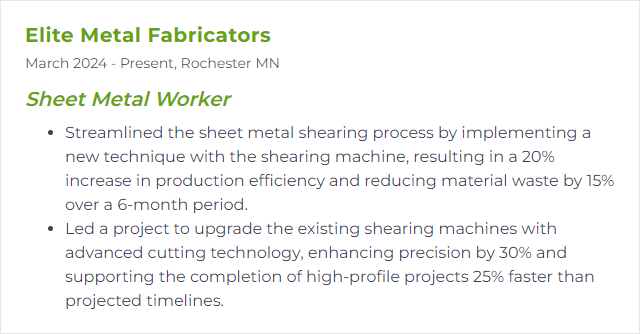
10. Riveting Techniques
Riveting joins metals by inserting a rivet through aligned holes and mechanically deforming it to clamp parts together. Solid rivets and blind (pop) rivets are common in sheet work.
Why It's Important
It creates strong, permanent joints without melting base metal—handy for thin sheets, coated materials, and heat-sensitive assemblies.
How to Improve Riveting Techniques Skills
Consistency comes from prep and control:
Right rivet, right hole: Match diameter to material stack-up and grip range; drill clean holes with correct clearance.
Alignment: Use clamps and fixtures to hold parts tight. Misalignment weakens joints.
Tool upkeep: Keep rivet guns, bucking bars, and nosepieces clean and in good condition.
Set quality: Check shop heads for diameter, height, and symmetry. Rework any outliers immediately.
Material care: Deburr holes and protect finishes to prevent cracking or corrosion paths.
How to Display Riveting Techniques Skills on Your Resume
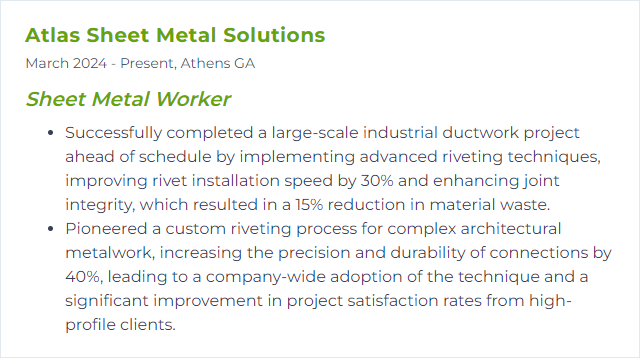
11. Sheet Metal Layout
Sheet metal layout is planning and marking cut lines, bend lines, and allowances so flat stock forms into the final part with minimal waste and fuss.
Why It's Important
Good layouts cut scrap, prevent rework, and make downstream forming more predictable.
How to Improve Sheet Metal Layout Skills
Blend craft and tools:
CAD-driven accuracy: Create clear drawings with bend notes, reliefs, and allowances the shop understands.
Nesting strategy: Arrange parts to save material while allowing for kerf, heat, and part stability during cutting.
Standardize: Use templates for common features and maintain bend charts tied to actual shop results.
Marking and ID: Use legible, consistent markings that survive handling but won’t mar finished faces.
Feedback loop: Capture lessons from forming and welding back into your flat patterns.
How to Display Sheet Metal Layout Skills on Your Resume
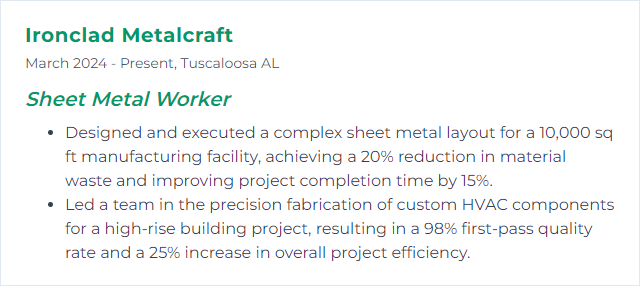
12. HVAC Systems
HVAC systems control temperature, humidity, and air quality. Sheet metal workers fabricate, install, and repair ductwork, dampers, and fittings that move air where it needs to go.
Why It's Important
Comfort, safety, and energy efficiency depend on airtight ducts, correct sizing, and clean airflow paths. Poor ductwork wastes power and frustrates building occupants.
How to Improve HVAC Systems Skills
Boost performance and durability in the field:
Seal and insulate: Seal joints, seams, and penetrations thoroughly; insulate where specified to cut losses and condensation.
Airflow-friendly layouts: Keep runs short, reduce sharp elbows, size trunks and branches properly, and balance with dampers.
Use proven standards: Follow respected guidelines for duct construction, leakage classes, and installation practices.
Quality fittings: Fabricate smooth transitions, takeoffs, and radius elbows to lower static pressure.
Maintenance access: Install service panels and keep filters accessible to simplify upkeep and extend system life.
How to Display HVAC Systems Skills on Your Resume

